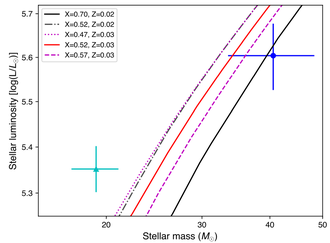
The celebrated X-ray binary Cyg X-1 contains the first black hole ever detected in our Universe. This happened with papers of Bolton (1972) and Webster and Murdin (1972) who measured the radial velocities of the observed supergiant component of the system and indicated that the unseen companion which is orbited by the supergiant is probably a black hole. Paczyński (1974) demonstrated that the observationally determined mass of the unseen companion depends only on the distance to the system and if the distance is large (greater than 1.3 kpc) then it must be a black hole. Ziółkowski (2005) constructed evolutionary models of the supergiant and concluded that its mass is about 40 ± 5 solar masses which translates into mass of the black hole of 20 ± 5 solar masses. These values were substantially larger than commonly used ones and were not generally accepted at that time.
The present paper published by the international team including Janusz Ziółkowski from CAMK contains two major parts. The first one analyzes the radio VLBI observations carried out by the group lead by J. Miller-Jones. The analysis provides the precise determination of the radio parallax of the system translating into the distance of 2.22 ± 0.17 kpc. The second part uses this result and the other observational data to determine the parameters of the binary system. The particularly interesting are the obtained values of the masses of the components: 40.6 ± 7.4 and 21.2 ± 2.2 solar masses. These values are substantially higher than the ones believed until recently. They have very serious consequences for the picture of the evolution of the massive stars, in particular implying that the wind mass loss from these stars is substantially weaker than earlier estimated.
Impact of this work: between February 17th and Feb 22nd, 364 articles about this work have been read by an estimated *actual audience of 2.3 million people in 54 countries. The majority of media coverage occurred in the US (72 articles) followed by China (54 articles), UK (21 articles), India (19 articles),
the Spain (18 articles), and Switzerland (17).
Figure caption: Predicted mass-luminosity relations for high-mass core hydrogen burning stars of different chemical compositions. Masses are given in solar masses, and luminosities relative to the solar luminosity. The relations show the positions of partially evolved stars at the moment they have the effective temperature and the stellar wind mass loss rate corresponding to those observed for the supergiant in Cyg X-1. The mass and luminosity determined by Orosz et al. (2011) are shown as the cyan triangle. The values from this work are shown as the blue circle.






